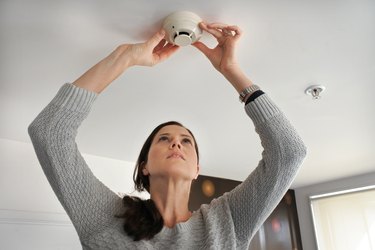
Hidden cameras come in a variety of forms, and smoke detectors are a common medium. The cameras are used for basic home security and monitoring and in some cases for spying. If you're suspicious of a camera in your house, remove the smoke detector for a full inspection or simply replace it for peace of mind. The presence of a hidden camera in a house or place of business that's outside your ownership is entirely possible. Homeowners and parents especially will use hidden cameras to monitor infants, babysitters and anyone entering their houses in their absence. A hidden camera in a bathroom is simply not acceptable in any scenario, but in a common area, spy cameras are not uncommon.
Spy Camera Legality
Video of the Day
Hidden camera laws vary on a state by state basis. In most states, cameras are not legal in an area where you're expected to have privacy. Bathrooms, locker rooms, changing rooms, a doctor's office and other areas where privacy is mandatory are illegal zones for hidden cameras. Otherwise, businesses and homeowners or occupants can use cameras for their security systems. If a camera is being used legally, you may visually identify the camera, but removing the smoke detector and tampering with the camera is illegal because, at that point, you're destroying property.
Video of the Day
Wire Detection
Smoke detectors use a very low amount of electricity and are battery operated. Many smoke detector cameras are also battery operated with WiFi capabilities. Models running nonstop with recording features may, however, have wires attached and running to a power source or recording device. If you see a smoke detector with wires attached, this could indicate the presence of a camera. Most owners will attempt to hide the wires or place the smoke detector camera in an area with low visibility, but protruding cords are a giveaway.
Lens Detection
Hidden cameras still require a lens with a clear view of the room. Although hidden camera lenses are often very small, they remain visually detectable. Look for smoke detectors placed in areas where a lens would have a full view of the room or space. After locating the smoke detectors that are candidates for a camera, visually inspect the smoke detector and look for a small black dot and pinhole openings that provide the lens with perspective and a visual window. Like any camera lens, it will reflect and have a distinct visual appearance. Shining a flashlight on the smoke detector will make lens detection much easier. You can also find a hidden camera detector app for iPhone free in the iTunes store. The app is not 100 percent accurate, but it can help locate the lens when pointed directly at the smoke detector.